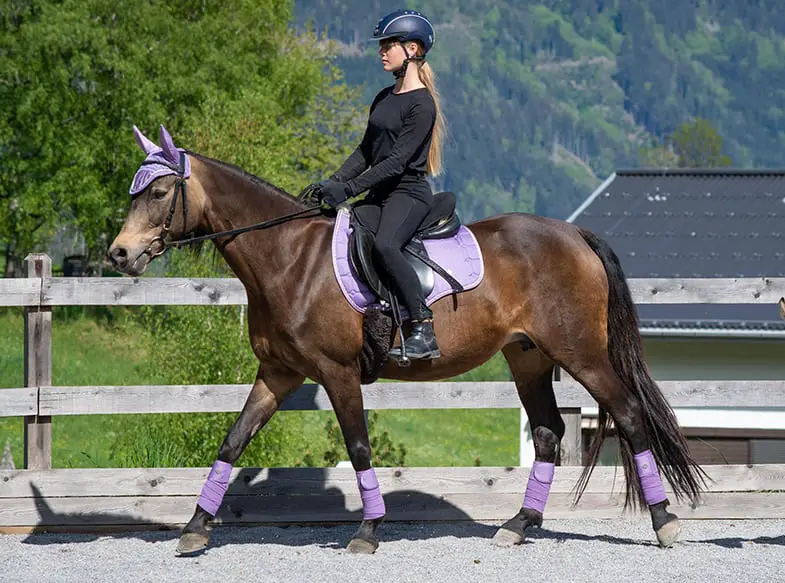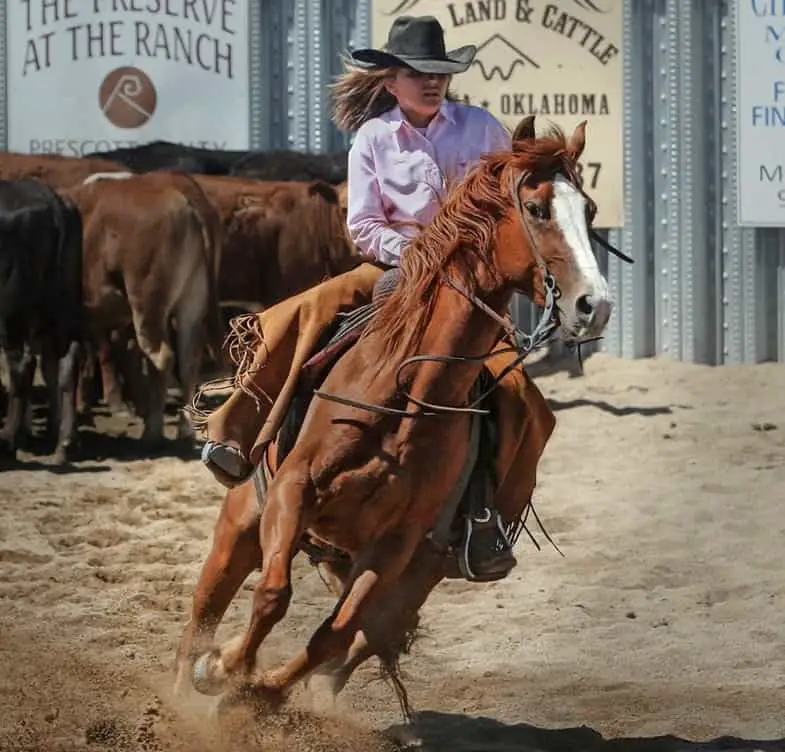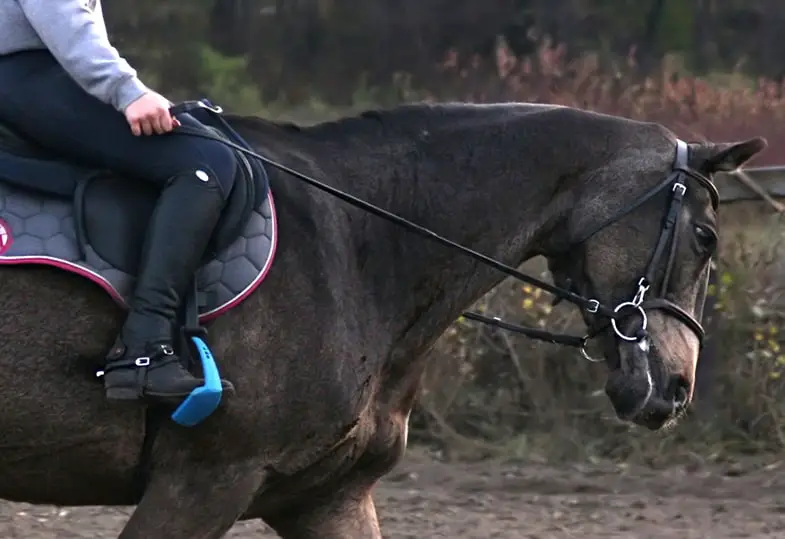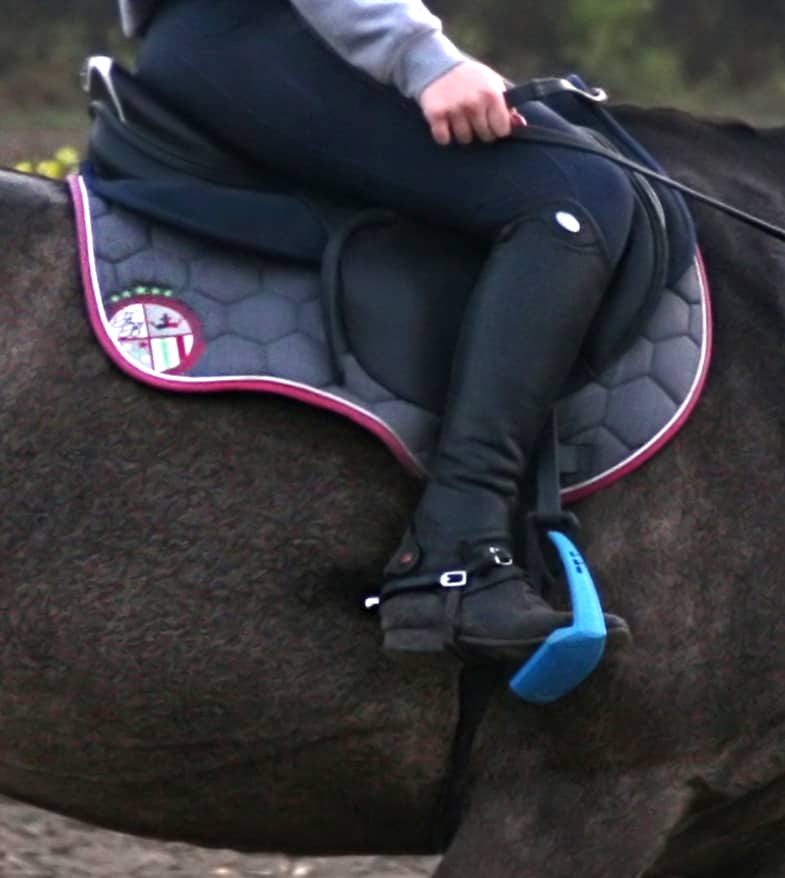Horseback riding may look effortless, especially when you see a horse and rider in perfect harmony but there’s more to riding than just sitting on a horse. It can take a lot of practice to get right and every rider will, at some point, develop a few bad habits. To some extent, this is part of the course but that doesn’t mean to say they don’t need to be addressed.
As a qualified riding instructor, I’ve seen a lot of bad habits over the years but some are far more common than others which is why I decided to write this article. I wanted to draw attention to the most common riding mistakes people make and also help to fix them.
I’ve grouped all of the mistakes into categories to make it easier for you to find (and then fix) the mistakes you’re making.
Riding posture
Balance is key to being an effective horseback rider, it plays a crucial role in keeping you in control of the horse but will also have a big impact on the horse. If you have a good posture and are properly balanced the horse won’t have to work so hard.
1) Looking down
The head is one of the heaviest parts of our body and looking down will alter your center of gravity and cause you to tip forwards.
Why is this important?
There are two reasons why you need to keep your head up while you’re riding, firstly if you’re looking where you’re going you’ll be able to prepare for any obstacles ahead but more important is the effect it’ll have on your horse. By looking down you’ll automatically be tipping your weight forward which will mean you’re not centered in the saddle. This will mean that your horse has to constantly re-adjust his balance to compensate for you.
How to fix this
Place markers around the area and practice riding towards them while maintaining your focus. It might seem odd at first but eventually, you’ll get the hang of it, ideally, you should be looking between your horse’s ears with your focus being roughly ten feet in front of him.
2) Slouched shoulders
Your shoulders slouch forward and alter your center of gravity.
Why is this important?
If your shoulders are rounded and sloped forward you won’t have as much control over the horse because you won’t be able to give them effective cues with the reins. On top of that, you’ll also find it far harder to maintain a good seat and, over time, are likely to suffer from back and shoulder pain.
How to fix this
You need to be conscious of your shoulders and try to keep them back. If you find this difficult to do you can always try a back brace to help you. There are a number of full back braces on Amazon but I personally prefer, and recommend, this one (also on Amazon) because it helps to keep your shoulders back but doesn’t restrict your lower back.
3) Leaning forward
You lean too far forward instead of sitting upright.
Why is this important?
If you’re leaning too far forward and the horse trips or suddenly stops then there’s every chance you could fall off. Also, leaning forward when you’re doing flat work will alter your center of gravity and unbalance you in the saddle. This will make the horse harder to control but could also make them spooky if they think a predator is hanging onto their neck.
How to fix this
Sitting deep into the saddle with your back straight and your shoulders back will make it virtually impossible for you to lean forward without realizing it. You can also practice holding your arms out to the side with eggs sitting on each hand. If you start to lean forward the egg will roll, the key is to keep the egg in the center of your hand.
4) Hollow back
We’re always told to sit up and keep our shoulders back which is right but in doing so we often overcompensate and arch our backs in an effort to ‘sit up straight’.
Why is this important?
If your back is arched you won’t be able to move in time with your horse which will affect your balance. Over time it will also lead to lower back pain due to constantly straining to keep your balance.
How to fix this
After you’ve mounted the horse, but before you begin riding take a few deep breaths. It’ll help you to relax which will also cause you to relax your shoulders and therefore not strain your back.
5) Reclining chair
You relax into the horse and end up sitting as though you’re on a reclining chair rather than on a horse.
Why is this important?
Sitting like this will shift your weight too far back and make it harder for your horse, but it will also push your legs forward which reduces your ability to communicate with the horse. Depending on how far back you’re sitting it can also weaken your control because your hands aren’t in the right position to use the reins effectively.
How to fix this
It’s important to be relaxed while you’re riding but not so much so that you let the horse do all of the work. Taking your feet out of the stirrups and letting them hang loose for a few minutes will help ‘reset’ your chair position.
6) Leaning in on turns
Leaning in as your horse turns.
Why is this important?
Your horse will find it much harder to keep his balance if you’re not centered, especially in tight turns. In some very extreme cases (and seriously tight and fast turns) your horse could even fall.
How to fix this
Have you ever watched barrel racers or reiners when they turn? You’ll notice that the may lower their weight by sitting deeper into the saddle but they keep looking ahead and always keep their body upright.
7) Tension (not breathing)
Holding your breath will cause your body to be tense.
Why is this important?
Holding your breath with make it harder for you to focus and make decisions but it can also lead to your body being tense which will make the horse nervous too. If the horse is nervous not only will they be less likely to perform to their best but they might spook too.
How to fix this
We all have smartphones and watches these days so make use of the breathing app on it before your ride. This will help to relax you before you start but while you are riding try and be conscious of your breathing. Ideally, you should be taking deep breaths, they’ll help you focus and stay relaxed more than shallow breaths will.
Arms (and hands)
You might not think that your hands and arms are important when you’re riding but they’re your main form of communication with your horse so it’s important you’re using them properly.
8) Tight elbows
Your elbows are tight and your arms are dead straight.
Why is this important?
Not only will this reduce the effectiveness of your cues but it will also unbalance you. If you keep your arms like this for any length of time they’ll ache too.
How to fix this
If you find it difficult to relax your arms when you’re riding try loosening the reins and little and resting your hands on the horn (or pommel). This isn’t the ideal position for your hands but it will help you to relax your arms. When you think your arms are relaxed and that you won’t tighten them up again, return your hands back to the correct position (approximately a fists height above the horse’s withers).
9) Elbows sticking out
Sometimes referred to as ‘chicken wings’, your elbows stick out rather than stay close to your body.
Why is this important?
Just as is the case with tight elbows, having them stick out will affect your balance and reduce the efficiency of your cues.
How to fix this
Move your shoulders up and down as well as backward and forwards a few times before you pick up the reins, this will help you to get rid of any tension in your arms and will help you to keep your elbows by your side. From time to time while you’re riding check yourself to make sure your elbows aren’t pointing outwards.
10) Tight and restrictive hands
Holding your reins too tightly and not allowing the horse to move his head.
Why is this important?
You’re putting too much pressure on the horse’s mouth which will make your communications inconsistent. Constantly pulling on the horse’s mouth can also cause them to become unresponsive, pull, move backward, rear up or toss their head, therefore reducing your control.
How to fix this
Practice holding an egg in each hand, don’t squeeze so hard that you break them but make sure you’re holding them tight enough so that they don’t fall, that is how tightly you should hold the reins.
If you find the reins make your hands sore you might want to think about gloves: Pros and cons of wearing gloves for riding.
11) Loose hands
Not having a proper grip on the reins.
Why is this important?
Holding the reins loosely means that the horse can easily pull them out of your hands if he stretches or puts his head down.
How to fix this
If you’re not sure how tightly you should be holding the reins imagine you’re holding a baby chick instead of the reins. Holding it too tightly will hurt the chick but not holding it tight enough will cause it to fall from your hands.
Legs (and feet)
Like your arms, your legs play a crucial role in communicating with your horse, if you don’t have them in the right place you’ll be affecting your balance and confusing your horse.
12) Gripping with your knees
In an effort to stay on you grip the horse with your knees.
Why is this important?
It can make it much harder to be smooth when you’re riding, especially when you sit the trot. Instead of being able to lower yourself softly back into the saddle, you’ll bounce back down which can hurt your horse’s back.
How to fix this
Relax and grip with your calves and thighs instead of your knees.
13) Toes stick out
Your toes stick out to the side or are too far forward.
Why is this important?
If your feet are positioned incorrectly it’ll unbalance your seat (in turn unbalancing your horse) and make your leg aids less effective.
How to fix this
Nine times out of ten your toes are sticking out because your legs aren’t in the right place or you’re gripping your horse too tightly. Ideally, your legs should hang naturally against your horse without ‘holding onto them’. If you find yourself doing this then imagine you’re cuddling your horse instead.
If your legs are correct but your toes are still sticking out then make sure they’re resting in the stirrups properly, if anything you can push down with your heels a bit.
14) Your heels are up
Your knees are too tight so your heels rise up.
Why is this important?
Not only does it unbalance you and your horse but it also makes your legs aid less effective because you’re reducing the amount of contact you have with your horse.
Keeping your heel down also helps you to keep your feet in the stirrups.
How to fix this
Around half of all riders who have their heels up do so because their stirrups aren’t the right length for them. They’re either too long and the rider ends up holding their legs in place or they’re too short and the rider’s heels are automatically brought up. If this is you make sure your stirrups are the right length, typically the stirrup leather should be the same length as your arm.
The rest have their heels up because they don’t have their feet in the stirrups properly. They’ve put their foot too far through and are tipping their toes forward. If this is you then make sure the balls of your feet are resting in the stirrups.
How to correct your horse riding mistakes out of the saddle
We spend most of our lives out of the saddle so it stands to reason that improving things such as your posture and overall fitness out of the saddle will have a marked improvement on your riding. Below are a few things you should practice in your day-to-day life when you’re not riding.
Posture
We spend so much of our time slouched over our computers that it’s no wonder so many people suffer from lower back pain. Even when we walk now we often have our heads down, either looking at our phones or watching our footsteps. While it might seem uncomfortable to do at first you can easily break this habit by positioning your screen so that you have to have your head up to look at it. Adjusting your chair so that your arms are at a 45-degree angle will also help you to relax your shoulders and prevent you from slouching.
I know it’s going to sound like a really silly thing to say but when you’re out walking try and look where you’re going. Looking ahead of you, rather than down at the floor, will not only help you to stand up straight but will also improve your position in the saddle.
Fitness
Any experienced equestrian will tell you that the rider’s fitness is as important (if not more so) than the horse’s fitness. If you’re not fit you won’t be able to maintain your balance and will therefore be bouncing around in the saddle, forcing the horse to work harder. You don’t have to be as fit as an elite athlete but just fit enough to be able to maintain your position and not tire after a few minutes in the saddle.
There are a few exercises you can do to improve your core muscles and they will certainly help but if you don’t feel like doing ‘exercises’ then why not go for a walk instead. Providing your standing up straight, walking will help to improve your core as it’s engaging all of the relevant muscles.
Stress and relaxation
We spend so much of our lives on fast-forward that it can be difficult to relax which is why I always suggest practicing mindfulness. I know it’s the latest craze that everybody’s talking about but I know from experience how good it is.
Rather than trying to slow down, pay attention to what you’re doing right now instead of thinking about what you’re going to be doing next. It’ll help you to focus on what you’re doing but will also help you to relax too, something your horse will really notice.
I know it’s not horsey related but I first read about mindfulness in a book by a Buddhist monk called Thich Nhat Hanh. I was skeptical at first but was amazed at how well it worked. The book’s called ‘The miracle of mindfulness’ and I would highly recommend it. You can buy it on Amazon for around $10 if you want to give it a go.
I hope you found this article helpful. If you did I’d be grateful if you could share it please as it would really help me.
Recommended products
Over the years I have tried hundreds of different horsey products, from various blankets and halters to different treats. Some I’ve loved, others I’ve hated but I thought I’d share with you my top all-time favorite products, the ones I never leave the yard without. I’ve included links to the products (which are in no particular order) that I really think are great.
- Horse Knots by Reference Ready – If you’re like me and enjoy pocket reference guides then you’ll love this knot tying guide. These handy cards can easily fit in your pocket or attach to the saddle for quick reference. They’re waterproof, durable and are color coded to make them easy to follow.
- Mane ’n Tail Detangler – Even if you never show your horse you’ll need to detangle his tail from time to time (and possibly his mane too) which is always a challenging chore! I’ve found that if I run a little bit of detangler through my horse’s tails every few days it stops them from getting matted up and makes combing them easy, even if they’re coated in mud. I don’t know if I should admit to this or not but it also works wonders on my hair.
- TAKEKIT Pro clippers – Over the years I’ve tried a lot of different clippers and while some were obviously better than others I found these to be by far the best. They are heavier than a lot of other clippers but for me, that’s a good thing, it makes them feel more sturdy and hardwearing. On top of that they have a range of speeds so are just as good for clipping your horse’s back as they are his face. I also like the fact that they come in a handy carry case but that’s not for everybody. The company that makes them is super good and incredibly helpful too, a real bonus these days. The only thing I wasn’t keen on was the fact that it doesn’t come with any oil, but that’s not a major problem as it’s not difficult to buy lubricant.
- Shire’s ball feeder – There are so many boredom buster toys out there but I like to use these every day, regardless of whether or not my horses are bored. I find that it helps to encourage my horses to problem solve by rewarding them with treats (or pieces of fruit) but it also mimics their natural grazing behavior which helps to keep them calm and de-stressed.
- Horse safe mirror – This is a strange one that many people are surprised about but I like to put horse safe mirrors in the trailers as well as in the quarantine stalls. It helps to prevent the feeling of isolation by giving the impression of other horses being around. Being herd animals horses can get extremely stressed when they feel that they’re on their own but with these stick-on mirrors, they believe that at least one other horse is with them.
- Rectal thermometer – I know this isn’t glamourous at all but it’s vital for your horse’s well-being to be able to check their temperature and a rectal thermometer is the easiest way of doing this which is why I’ve added it to the list.
Shopping lists
I’ve also put together a few shopping lists of essential items that I’ve found helpful over the years. I’ve broken the lists down into different categories rather than put everything in one massive list 😉




